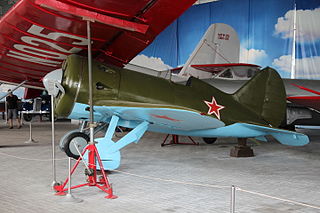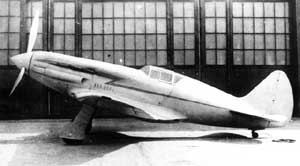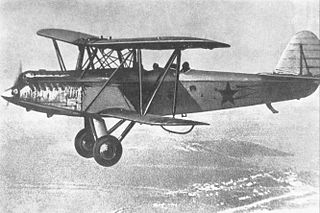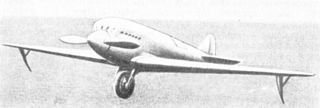
The Polikarpov I-16 is a Soviet single-engine single-seat fighter aircraft of revolutionary design; it was the world's first low-wing cantilever monoplane fighter with retractable landing gear to attain operational status and as such "introduced a new vogue in fighter design". The I-16 was introduced in the mid-1930s and formed the backbone of the Soviet Air Force at the beginning of World War II. The diminutive fighter, nicknamed "Ishak" or "Ishachok" by Soviet pilots, figured prominently in the Second Sino-Japanese War, the Battle of Khalkhin Gol, Winter War and the Spanish Civil War – where it was called the Rata ("rat") by the Nationalists or Mosca ("fly") by the Republicans. The Finns called the aircraft Siipiorava "(flying squirrel)".

The Mikoyan-Gurevich MiG-1 was a Soviet fighter aircraft of World War II that was designed to meet a requirement for a high-altitude fighter issued in 1939. To minimize demand on strategic materials such as aluminum, the aircraft was mostly constructed from steel tubing and wood. Flight testing revealed a number of deficiencies, but it was ordered into production before they could be fixed. Although difficult to handle, one hundred were built before the design was modified into the MiG-3. The aircraft was issued to fighter regiments of the Soviet Air Forces (VVS) in 1941, but most were apparently destroyed during the opening days of Operation Barbarossa, the German invasion of the Soviet Union in June 1941.

The Kharkiv KhAI-5, was a Soviet reconnaissance and light bomber aircraft, designed in the mid-1930s in the Kharkiv Aviation Institute, under the direction of Iosif Grigorevich Nyeman.

The Ilyushin DB-3, where "DB" stands for Dalniy Bombardirovschik meaning "long-range bomber", was a Soviet bomber aircraft of World War II. It was a twin-engined, low-wing monoplane that first flew in 1935. 1,528 were built. The DB-3 was the precursor of the Ilyushin Il-4.
The Tupolev ANT-7, known by the VVS as the Tupolev R-6, was a reconnaissance aircraft and escort fighter of the Soviet Union. The R-6 traces its roots back to early 1928 when the Soviet Air Force needed a long-range multirole aircraft. The requirements were that it could be used for long-range transport, defensive patrolling, reconnaissance, light bombing and torpedo attack.

The Tupolev TB-3 was a monoplane heavy bomber deployed by the Soviet Air Force in the 1930s and used during the early years of World War II. It was the world's first cantilever wing four-engine heavy bomber. Despite obsolescence and being officially withdrawn from service in 1939, the TB-3 performed bomber and transport duties throughout much of World War II. The TB-3 also saw combat as a Zveno project fighter mothership and as a light tank transport.

The Mikoyan-Gurevich DIS was a prototype Soviet heavy fighter of World War II, envisioned to serve primarily in the escort fighter role. The service designation MiG-5 was reserved for the production version of the aircraft. Competing designs in the USSR included the Grushin Gr-1, Polikarpov TIS and Tairov Ta-3.

The Polikarpov I-15 was a Soviet biplane fighter aircraft of the 1930s. Nicknamed Chaika because of its gulled upper wings, it was operated in large numbers by the Soviet Air Force, and together with the Polikarpov I-16 monoplane, was one of the standard fighters of the Spanish Republicans during the Spanish Civil War, where it was called Chato (snub-nose).

The Beriev MBR-2 was a Soviet multi-purpose flying boat which entered service with the Soviet Navy in 1935. Out of 1,365 built, 9 were used by foreign countries including Finland and North Korea. In Soviet Union it sometimes carried the nickname of "Kорова" (cow) and "Амбар" (barn).

The Polikarpov I-5 was a single-seat biplane which became the primary Soviet fighter between its introduction in 1931 through 1936, after which it became the standard advanced trainer. Following Operation Barbarossa, which destroyed much of the Soviet Air Forces (VVS), surviving I-5s were equipped with four machine guns and bomb racks and pressed into service as light ground-attack aircraft and night bombers in 1941. They were retired in early 1942 as Soviet aircraft production began to recover and modern ground-attack aircraft like the Ilyushin Il-2 became available. A total of 803 built.

The Sukhoi Su-6 was a Soviet ground-attack aircraft developed during World War II. The mixed-power high-altitude interceptor Su-7 was based on the single-seat Su-6 prototype.

The Polikarpov R-5 was a Soviet reconnaissance bomber aircraft of the 1930s. It was the standard light bomber and reconnaissance aircraft of the Soviet Air Force for much of the 1930s, while also being used heavily as a civilian light transport, some 7,000 being built in total.

The Polikarpov R-Z was a Soviet reconnaissance bomber aircraft of the 1930s. It was a revised version of the Polikarpov R-5 which was built in large numbers between 1935 and 1937. It was used in combat during the Spanish Civil War as well as the Winter War and Battle of Khalkhin Gol.

The Heinkel HE 5, produced in Sweden as the Svenska S 5 and nicknamed the "Hansa", was a reconnaissance floatplane built during the 1920s. It was a further development of the HE 1, sharing its same basic configuration as a low-wing, strut-braced monoplane. The HE designation also refers to the monoplane construction, standing for Heinkel Eindecker.

The Polikarpov I-3 was a Soviet fighter designed during the late 1920s. It entered service in 1929, but was retired in 1935 with the advent of fighters with higher performance.

Kochyerigin DI-6 was a two-seat fighter biplane produced in the Soviet Union in the 1930s.

The Polikarpov I-6 was a Soviet biplane fighter prototype of the late 1920s. It was designed with traditional wooden construction in comparison with the wood and steel tube construction Polikarpov I-5. Its development took longer than planned and the lead designer, Nikolai Polikarpov, was arrested for industrial sabotage, which only further delayed the project. Only two prototypes were built, as the I-5 was selected for production.

The Polikarpov I-17 was a Soviet single-seat fighter prototype designed and built by a team headed by Nikolai Polikarpov at the Central Design Bureau (TsKB) in 1934.

The Bartini Stal-6, was a single-engined experimental aircraft designed, built and tested in the USSR from 1930.
The Ilyushin DB-4 or TsKB-56 was a Soviet twin-engined bomber aircraft of the early 1940s. It was a development of the Ilyushin DB-3 and was intended as a replacement for the earlier aircraft, but only two prototypes were built; engine problems and the need to concentrate production on existing types following the German invasion of the Soviet Union in June 1941 meant that no more examples were built.


















